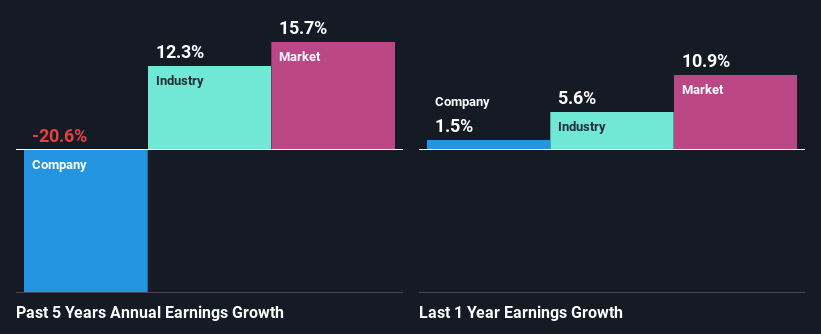- Saudi Arabia
- /
- Professional Services
- /
- SASE:1831
Maharah for Human Resources Company's (TADAWUL:1831) On An Uptrend But Financial Prospects Look Pretty Weak: Is The Stock Overpriced?

Most readers would already be aware that Maharah for Human Resources' (TADAWUL:1831) stock increased significantly by 24% over the past three months. We, however wanted to have a closer look at its key financial indicators as the markets usually pay for long-term fundamentals, and in this case, they don't look very promising. In this article, we decided to focus on Maharah for Human Resources' ROE.
Return on equity or ROE is an important factor to be considered by a shareholder because it tells them how effectively their capital is being reinvested. In other words, it is a profitability ratio which measures the rate of return on the capital provided by the company's shareholders.
See our latest analysis for Maharah for Human Resources
How Is ROE Calculated?
The formula for ROE is:
Return on Equity = Net Profit (from continuing operations) ÷ Shareholders' Equity
So, based on the above formula, the ROE for Maharah for Human Resources is:
20% = ر.س129m ÷ ر.س636m (Based on the trailing twelve months to June 2024).
The 'return' is the income the business earned over the last year. That means that for every SAR1 worth of shareholders' equity, the company generated SAR0.20 in profit.
What Is The Relationship Between ROE And Earnings Growth?
We have already established that ROE serves as an efficient profit-generating gauge for a company's future earnings. Depending on how much of these profits the company reinvests or "retains", and how effectively it does so, we are then able to assess a company’s earnings growth potential. Assuming all else is equal, companies that have both a higher return on equity and higher profit retention are usually the ones that have a higher growth rate when compared to companies that don't have the same features.
Maharah for Human Resources' Earnings Growth And 20% ROE
At first glance, Maharah for Human Resources' ROE doesn't look very promising. Yet, a closer study shows that the company's ROE is similar to the industry average of 25%. But Maharah for Human Resources saw a five year net income decline of 21% over the past five years. Remember, the company's ROE is a bit low to begin with. Therefore, the decline in earnings could also be the result of this.
So, as a next step, we compared Maharah for Human Resources' performance against the industry and were disappointed to discover that while the company has been shrinking its earnings, the industry has been growing its earnings at a rate of 12% over the last few years.

The basis for attaching value to a company is, to a great extent, tied to its earnings growth. It’s important for an investor to know whether the market has priced in the company's expected earnings growth (or decline). Doing so will help them establish if the stock's future looks promising or ominous. Is Maharah for Human Resources fairly valued compared to other companies? These 3 valuation measures might help you decide.
Is Maharah for Human Resources Using Its Retained Earnings Effectively?
Maharah for Human Resources has a high three-year median payout ratio of 81% (that is, it is retaining 19% of its profits). This suggests that the company is paying most of its profits as dividends to its shareholders. This goes some way in explaining why its earnings have been shrinking. With only very little left to reinvest into the business, growth in earnings is far from likely. You can see the 2 risks we have identified for Maharah for Human Resources by visiting our risks dashboard for free on our platform here.
Moreover, Maharah for Human Resources has been paying dividends for five years, which is a considerable amount of time, suggesting that management must have perceived that the shareholders prefer consistent dividends even though earnings have been shrinking. Upon studying the latest analysts' consensus data, we found that the company's future payout ratio is expected to rise to 780% over the next three years. Still, forecasts suggest that Maharah for Human Resources' future ROE will rise to 34% even though the the company's payout ratio is expected to rise. We presume that there could some other characteristics of the business that could be driving the anticipated growth in the company's ROE.
Conclusion
Overall, we would be extremely cautious before making any decision on Maharah for Human Resources. As a result of its low ROE and lack of much reinvestment into the business, the company has seen a disappointing earnings growth rate. That being so, the latest industry analyst forecasts show that the analysts are expecting to see a huge improvement in the company's earnings growth rate. Are these analysts expectations based on the broad expectations for the industry, or on the company's fundamentals? Click here to be taken to our analyst's forecasts page for the company.
New: Manage All Your Stock Portfolios in One Place
We've created the ultimate portfolio companion for stock investors, and it's free.
• Connect an unlimited number of Portfolios and see your total in one currency
• Be alerted to new Warning Signs or Risks via email or mobile
• Track the Fair Value of your stocks
Have feedback on this article? Concerned about the content? Get in touch with us directly. Alternatively, email editorial-team (at) simplywallst.com.
This article by Simply Wall St is general in nature. We provide commentary based on historical data and analyst forecasts only using an unbiased methodology and our articles are not intended to be financial advice. It does not constitute a recommendation to buy or sell any stock, and does not take account of your objectives, or your financial situation. We aim to bring you long-term focused analysis driven by fundamental data. Note that our analysis may not factor in the latest price-sensitive company announcements or qualitative material. Simply Wall St has no position in any stocks mentioned.
About SASE:1831
Maharah for Human Resources
Provides manpower services to public and private sectors in Saudi Arabia and the United Arab Emirates.
Reasonable growth potential with proven track record.


